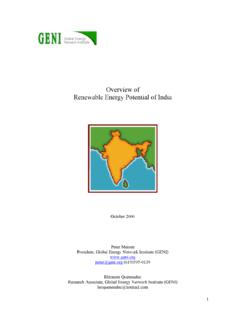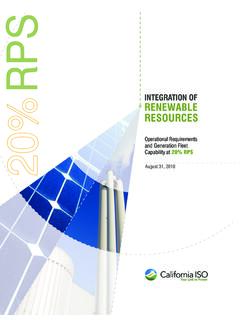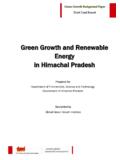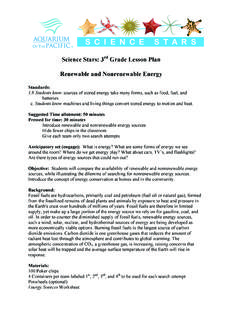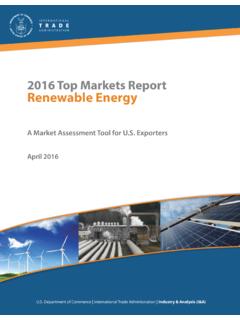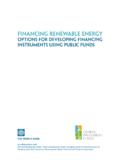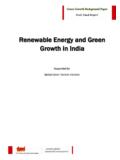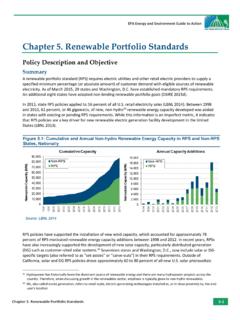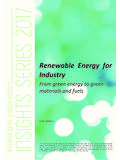Transcription of Revised version published in Harnessing …
1 EI @ Haas WP 202R Building Blocks: Investment in renewable and Non- renewable Technologies James Bushnell Revised April 2010 Revised version published in Harnessing renewable Energy in Electric Power Systems, Resources for the Future Press, 2010. Energy Institute at Haas working papers are circulated for discussion and comment purposes. They have not been peer-reviewed or been subject to review by any editorial board. 2010 by James Bushnell. All rights reserved. Short sections of text, not to exceed two paragraphs, may be quoted without explicit permission provided that full credit is given to the source. 1 Building Blocks: Investment in renewable and Nonrenewable Technologies James Bushnell Iowa State University and NBER April, 2010 1. Introduction Within a span of 20 years, the electric power industry has become the central focus of two extraordinary policy trends, each one significant enough to fundamentally reshape the industry.
2 One of these trends is liberalization, a term that has come to encompass both privatization and regulatory restructuring. Beginning with the visions articulated in such works as Joskow and Schmalansee (1985) and Schweppe et al. (1988), the restructuring movement in electricity can be viewed as an extension of the trend toward market liberalization that had previously transformed the airline, communications, and natural gas industries. The generation sector of the industry has undergone a sporadic but inexorable transition from economic regulation under cost-of-service principles to an environment in which markets heavily influence, if not dominate, the remuneration and investment decisions of firms. The second trend to engulf the electricity industry has been the growth of the environmental movement. More specifically, the growing alarm over the threat of global climate change, and the more recent engagement of policymakers in combating it, is likely to dominate decision making in the power industry over the next several decades.
3 Electricity and heat production are 2 responsible for 40% of CO2 emissions in the United States and about 31% worldwide (Stern 2006). Although not obvious at first glance, these two trends, restructuring and environmental regulation, share many common ideological roots. In the United States, the growing stringency in air quality regulation was accompanied by an increased acceptance of market-based environmental regulations. These include cap-and-trade mechanisms, such as the program put in place to limit SO2 emissions under the 1990 amendments to the Clean Air Act (Ellerman et al. 2000). Regulators were also interested in experimenting with market-based incentives to promote alternative energy sources. Many trace the birth of the independent power industry to the passage of the Public Utilities Regulatory Policies Act (PURPA) in 1978. The PURPA legislation established mandates for the purchase of energy produced by qualifying small and renewable sources of generation (Joskow 1997; Kahn 1988).
4 Although inspired largely by environmental and energy security goals, the largest impact of PURPA is arguably in the resulting demonstration of the viability of smaller-capacity generation technologies and the nonutility generator business model. One important aspect of the independent power producer business model was the relative freedom and risk allowed in investment of new facilities. Investments are based on market-based long-term contracts and projections of market revenues, rather than regulatory findings of need and guaranteed cost recovery. The restructuring movement in the United States was led by states with the worst track records in utility investment (Ando and Palmer 1998). Although evidence suggests that operations have become more efficient in these states (Wolfram 2005), restructuring was primarily intended to improve the incentives of firms to make prudent investments (Borenstein and Bushnell 2000).
5 In some parts of the world, this general approach to 3 investment has come to dominate the industry. In many others, policymakers continue to search for the proper tools for balancing market incentives with concerns over reliability and adequacy of investment (Joskow 2005; Oren 2005). One central aspect of this search concerns the design of wholesale electricity markets and the payment streams they provide to suppliers. Markets can differ greatly on the primary sources of remuneration for generators, with some relying on energy and ancillary services markets, while others have established mechanisms for compensating suppliers for their installed or available capacity (Bushnell 2005; Cramton and Stoft 2005). This chapter studies the intersection of these two trends as they come to dominate the economics of the industry. In particular, it examines how the increasing penetration of intermittent renewable generation can change the economic landscape for merchant power investment in conventional thermal generation.
6 Currently, renewable generation earns revenues from a wide range of sources, from energy markets to government tax credits. The impact of renewable generation on the electricity markets in which they participate has to date been relatively modest outside of regions of high concentration such as west Texas. That will almost certainly change, however, as state and federal policies considerably ramp up the amount of renewable generation throughout the country. This can have a profound impact on prices and the economics of supply for both renewable and nonrenewable generation. An equilibrium model of generation investment is developed, based on the long-standing principles of finding the optimal mix of capital intensive and higher marginal cost resources to serve a market with fluctuating demand. This model is then applied to data on electricity markets from several regions of the western United States to examine how the interaction of increasing wind capacity and electricity market design affects the equilibrium mix of thermal capacity and 4 the revenues earned by renewable suppliers.
7 The chapter first provides a brief background on this question, then describes the equilibrium conditions that form the stylized investment model. Next, it details the data and assumptions used in the study. The final section contains the bulk of the results and analysis. 2. Background: renewable Energy in Restructured Electricity Markets renewable , or green, power is viewed by many policymakers as the key to combating greenhouse gas emissions within the power sector. Explicit and implicit subsidies for renewable power continue to grow. By the end of 2007, 25 states and Washington, DC, had some form of renewable portfolio standard (RPS), which requires purchasers of wholesale electricity to procure some percentage of their power from renewable sources (Wiser and Barbose 2008). The long-standing, but intermittent and precarious, production tax credit (PTC) for wind energy in the United States pays wind producers cents/kWh for energy production.
8 The American Recovery and Reinvestment Act of 2009 contained several provisions favorable to renewable generation, including the extension of the PTC until 2012 and alternative investment tax credits for facilities constructed in 2009 and 2010 (Wiser and Bolinger 2009). For the industry as a whole, the growth of nonutility generation has coincided with the expansion of renewable generation sources. This is not the product of happenstance; from the passage of PURPA, various legislative purchasing mandates and tax incentives played a dominant role in the growth of both renewable and nonutility generation. To this day, the renewable industry is dominated by nonutility 5 The subsidization of renewable generation is expanding in parallel with efforts to create cap-and-trade programs for CO2. This can be seen as antithetical to the spirit of a cap-and-trade program, where promoting flexibility in compliance options is a central ideal.
9 Unlike the SO2 program, cap-and-trade is but one of a broad set of policy tools being brought to bear against greenhouse gas (GHG) emissions. Some view this as undermining the strength of cap-and-trade regulation. The cap has less incremental impact if much of the GHG reductions are already accounted for under various more directed measures and regulations. In regions such as California, cap-and-trade is viewed more as a backstop than as a bulwark in combating climate change. Although policies that promote renewable generation sources are extremely popular with regulators, politicians, and the general public, their continued expansion to unprecedented levels does raise some concerns. One source of concern is cost. Although the technological frontier continues to advance, much controversy exists over the appropriate timing and form of policy intervention to promote renewable generation. Most accept that renewable generation would not be a significant source of supply today if not for some form of public support.
10 The fact that the external cost of GHG emissions have not yet been priced into the investment decisions of fossil-based generation firms certainly provides justification for support of renewable power, but the prospect of regional and possibly national caps on CO2 emissions undermines that justification. A common argument for support of renewable generation is the hope that expansion of supply will yield learning benefits, thereby lowering costs of future supply. However, a market failure exists only if that learning cannot be appropriated for private gain. Although the bulk of public support for renewable generation has taken the form of production mandates or credits, it is not clear whether commercialization is the point in the supply chain where the problem of intellectual property is most acute. Further, the evidence to date indicates that cost reductions in 6 alternative energy sources can be driven as much by exogenous technology developments as by the expansion of installed capacity (Nemet 2006).







